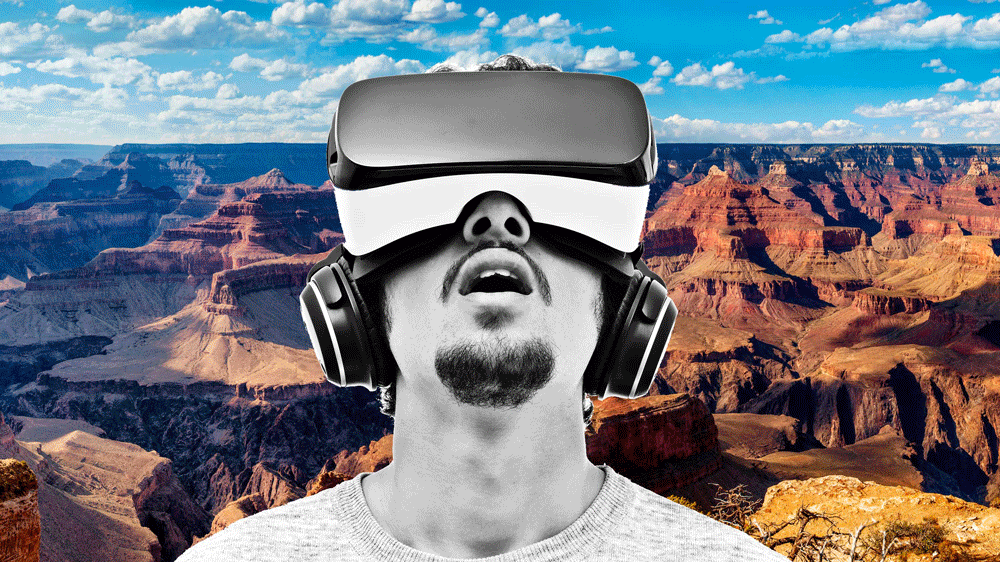Given the deluge of solicitations to virtually tour parks, museums, safaris, and cities flooding my inbox in the past few weeks, one might be tempted to think that the future of armchair travel is looking great!
And so in between our stories covering the entire travel industry grinding to a near-complete halt, I decided to go on as many of these “tours” as possible.
The world of virtual travel is a realm that until now I neither desired nor needed to visit. Quite simply, for me as for many of you, the world itself was wide open for exploration.
What I found out when I lifted the lid on digitally imagined journeys is a wild mix of highs and lows—some truly joyous experiences and some to which “what the fuck” was an understated response. Much of it is dominated by one giant tech company (Google). There are a plethora of lists around the internet touting great experiences, but I’d be surprised if the authors did more than a cursory glance through the offerings as many are not worth your time. While a future in which we are all obese and traveling through our headsets may happen some day, we’re far from that now.
I started with a couple rules. The technology needs to be easy to figure out, of reasonable quality, and in some form attempt to give viewers some of part of what it means to be there. This means that while many museums and the like have great lecture series online, to me at least those are more documentaries. It also means that after reading this article you need to be able to go and do it on your phone or laptop.
So, you’re in your home office hiding from whoever you’re sheltering with and just want to get away. What’s on your list? Perhaps you always wanted to go to the Louvre, and sure enough it’s on all the lists touting virtual experiences. It’s the first I checked out online because I was supposed to be in Paris right now and so I likely would have gone to see its new exhibition “The Advent of the Artist,” which discusses the rise of the modern concept of the artist.
Of all the “virtual tours” I came across, this was one of the best—if you speak French. The quality of the images is good, and you can move through the exhibition and stop on works quite seamlessly. But, alas, the real-life English picture cards are not always visible and so the VR French ones that pop up are, well, in French.
Audio would have been an easy fix for this dilemma, but audio capability is a feature inexplicably missing from nearly all VR experiences that I tried. It would have removed so much of the drag and click part of the experience that sucks the wonder and romance out of it.
The rest of the Louvre’s virtual tours that I could find were out of date (the one of the Galerie d’Apollon shouldn’t even be called a virtual tour) and its “VR” experience Mona Lisa: Beyond the Glass (which is an app you must download to use) was more of a mini doc than VR experience. (Although, the ending, when it imagines the entirety of the loggia and landscape from the painting, is pretty nifty.)
Across the Channel, London’s National Gallery also touts virtual tours. One of them is done with Google Street View, and while the images are pretty high quality, you can’t see any of the info about them. Which is what you most want to do anyway in a major art museum—aimlessly wander through, pretending to scrutinize a painting here or there and hope that through some form of osmosis you’ll come out more cultured.
On the other hand, for its Sainsbury Wing (focusing on 14th and 15th century painting), the museum teamed up with the VR company Oculus, and while I found it fun to “amble” around and discover new paintings, this tour has an annoying glitch wherein they’ve covered the caption cards full of context and details with a target circle that you hover over to give you the painting info which is just title, artist, date, material, and acquisition history.
And so from the Smithsonian Natural History Museum (unwieldy and the zoom to see what you’re actually looking at varies) on through the Palace Museum in Beijing (you can examine some items in exhibitions but all info is in Chinese and moving through is clunky) to the Vatican (the opening of the Sistine Chapel virtual tour is breathtaking, but details are blurry when you try to zoom), museum after museum either has utterly useless tech that is essentially just blurry 360 degree images of rooms or a good product that only a few can use. And none—unless I’m a moron who couldn’t figure things out (good chance there)—had audio, which seems like an obvious enhancement.
Speaking of a product that few can use, many museums have handed over their virtual reality experience to Google Arts & Culture. I’m ashamed to admit, I really hadn’t heard much about what is actually a behemoth in this space. Download and open the app and it’s chock full of “exhibitions” from museums all around the world. The only problem is that even when they seem like fantastic combos of audio, visual, and movement, like the one from MASP (the São Paulo Museum of Art, which is a favorite of mine) they require VR headsets (which most people don’t have) or Google’s cardboard glasses.
Yes, to experience all this high tech virtual reality tourism, you need to order Google’s cardboard glasses…
To be frank, scrolling through a lot of the offerings called “exhibitions” (like that of the Czech Republic National Museum’s natural history collection) reminded me of glorified versions of one of my favorite things from childhood—my CD-ROM Encyclopædia Britannica that was an endless rabbit hole of concise information, pictures, audio, and video. (Which is timely I suppose, as last week for our series on great travel books our foreign editor Chris Dickey notes that Aldous Huxley recommended “the best book to take along on a journey... is any one of the 32 volumes of the quarter-size Encyclopædia Britannica.”)
And despite the fancy graphics, Google’s joint project with the British Museum for the VR experience on their website is honestly just a modern version of the comparison timelines found on my old CD-ROM.
That said, the augmented reality gallery exhibition called “The Art of Color” on the Google Arts and Culture app was a genuine delight (and not just because it opens with a portrait by Bronzino), with paintings I wanted to see up super close, and could either view by walking around my house or just moving it on the screen with my hands. And lovers of Vermeer can indulge in having all his works in one show for the first time ever.
But a lot of the app is something I’ve realized I don’t care about at all—360 degree photos. They’re what is being pushed by a lot of destinations, whether it be the country of Chile in its Chile 360º app, the Biltmore House in North Carolina, or the particularly weird ones on offer from Disney Parks. I don’t care if it has me standing at the top of the Eiffel Tower or Easter Island at sunrise, there’s something sanitized about the experience that I find not worth it. And even when something is enticing, like the inside of a Concorde at the Museum of Flight, you do a full circle, go up and down the aisle, and then you’re… done.
So what, if anything, did I like?
We’ll start with one I’m on the fence with. While exploring Asheville, North Carolina’s virtual offerings, I was enlightened about another VR travel tool from Google called Google Trekker. (I don’t know if my lack of knowledge of the app as somebody who hikes a lot is a reflection on me or Google.) Essentially you can now take Street View on Google Maps all the way along some of the most popular hikes in the country, whether on the Blue Ridge Parkway or the Grand Canyon itself. I’m not a botanist, so a lot of hiking trails on the screen just looked like a dirt path with plants on either side, so I’m not sure about the appeal from a transportive point of view. Then again, I did find myself scrolling longer than I thought I would and could definitely imagine doing so for longer while stoned. And when one reaches the end points for these trails, such as a waterfall or majestic view, there is a non-edited quality to them that is different from what you’d find on Instagram. So consider me somewhat intrigued but unsure.
However, if you’re really looking for an escape inside something, your best bets are finding museums where the spaces themselves are so over the top that even wandering through them on your screen is a delight. Two easy ones to try are the Hermitage in St. Petersburg or The Elms in Newport, Rhode Island. (Whereas I found a lot of virtual tours of “cool” things like spacecraft to be very underwhelming on a screen without anybody telling me what I was looking at.)
Also, look for destinations that are doing more interactive travel experiences, like “Discover Puerto Rico,” which over the weekend organized three nights of activities on Instagram Live—salsa dancing lessons, cocktail classes, and cooking classes. Singita Sabi Sand in South Africa has been doing Instagram Live safaris.
Or, go deep into the collections that the museums make available online. One of my favorite escapes I stumbled across? The Getty has a lot of the rare books in its library available in their entirety online, and if you need a place to start, a great one is photography pioneer Félix Bonfils’ 1878 photographs from the Middle East, which are some of the earliest known to exist.
But for me, the best virtual escapes online are the ones in the natural world. Yes, even with all the technology of the past few years, animal cams are still the best virtual escape there is.
Earlier today I managed to spend 20 minutes of my morning by the side of a highway in Nebraska watching hundreds of cranes hop, bob, and plunge into the shallows to snag their unsuspecting prey. I then watched a highlight Live Cam of a leopard hitting up the watering hole in the middle of the night. I don’t know about you, but I could watch that majestic creature crouched and ready to beat it, warily lapping up water, for ages. All of my animal viewing I did on the Explore.org Live Streams, which I could nicely toggle based on what seemed to have action at that time, and if nothing was stirring I could go back through their best moments, which still felt to me like being on safari or bird watching again.
Should you, while sequestered, need to escape Netflix or that 2,000-piece jigsaw puzzle, it’s definitely worth exploring what’s being offered in virtual museums and travel. But the next time somebody tells me their qualms about technology or their fear of AI taking over soon, I will point them in the direction of these virtual tours in which the most esteemed minds in technology have said you need a cardboard box accessory to operate them.

